

Robin Davis teaching weaving NAIDOC 2012. Indigenous Weather Knowledge. Aboriginal and Torres Strait Islander people have developed an intricate understanding of the environment over many thousands of years.

Artist: Laurie Nilsen The artwork used in the design of this website represents the relationships between seasonal, meteorological and astronomical changes - and how the Mandandanji people read these changes to inform life on country. About the Indigenous Weather Knowledge website. Traditional Indigenous weaving at Shepparton Art Museum. Basket Weaving - Girl TV Australia @ Booderee National Park. Aboriginal Australia tours. Traditional tools - PALS Website. Australian Indigenous tools and technology. Warning.
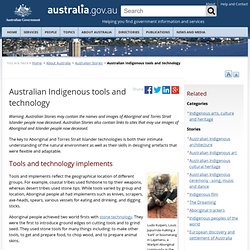
Australian Stories may contain the names and images of Aboriginal and Torres Strait Islander people now deceased. Australian Stories also contain links to sites that may use images of Aboriginal and Islander people now deceased. Aboriginal Hunting and Weapons. Before European Invasion, Aboriginal people and Torres Strait Islander people had a great variety of food to choose from.

These food sources came from the bush, the land, the seas and the waterways. A well balanced diet of fruits and vegetables, nuts and grains, meats and fish, oils and fats were hunted and gathered. Depending on the environment, where a family lived and the changes in seasons, the types of foods available would differ. Basket making. Basket Making Ngadjonji History of the Rainforest People Note: this site contains images of aboriginal people now deceased All early European visitors to the lands of the Ngadjonji and other North Queensland rainforest Aboriginies commented on the beauty and functionality of the distinctive two-cornered baskets, finely woven from split Lawyercane.
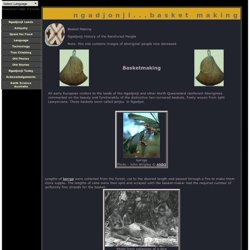
These baskets were called janjuu in Ngadjon. How To Make Cordage from Mat Rush (Lomandra) - Wilderness Survival, Tracking, and Awareness. This is a quick description of some cordage I made from Lomandra (Mat-rush).
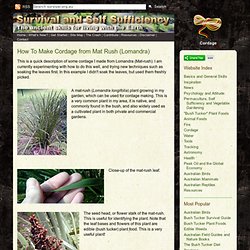
I am currently experimenting with how to do this well, and trying new techniques such as soaking the leaves first. In this example I didn't soak the leaves, but used them freshly picked. The difficult part in making this cordage is scraping the green sheath part of the leaves away from the useable fibres underneath, which is rather time consuming.
If enough of the green is not scraped away, when it dries out the cord will be brittle, and will snap when bent through a sharp angle (such as when tying in a knot). Mat-rush leaf being scraped, with fibres visible. The next step was twisting into 2-ply cord. Aboriginal Clothing. Traditional Aboriginal clothing was not the same in the whole Australia.
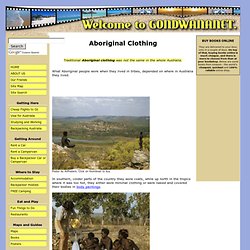
What Aboriginal people wore when they lived in tribes, depended on where in Australia they lived. Poster by AllPosters. Click on thumbnail to buy In southern, colder parts of the country they wore coats, while up north in the tropics where it was too hot, they either wore minimal clothing or were naked and covered their bodies in body paintings. Northern Warm Regions In warm regions in the tropical northern Australia, there was no need for clothes. History of Aboriginal and Torres Strait Islander textiles.
Aboriginal and Torres Strait Islanders make a variety of objects from animal and plant fibres.
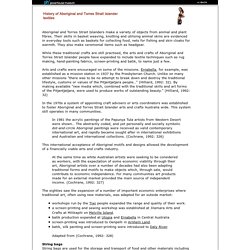
Their skills in basket weaving, knotting and utilising animal skins are evidenced in everyday tools such as baskets for collecting food, nets for fishing and skin cloaks for warmth. They also make ceremonial items such as headgear. While these traditional crafts are still practised, the arts and crafts of Aboriginal and Torres Strait Islander people have expanded to include textile techniques such as rug making, hand-painting fabrics, screen-printing and batik, to name just a few. Arts and crafts were encouraged on some of the missions. Ernabella, for example, was established as a mission station in 1937 by the Presbyterian Church. Tracking Animals - How To Read Animal Tracks. Bush Tucker Plant Food - All. Bush Food: 11/06/2013, Behind the News. For a lot of city kids the chance to go bush and learn about traditional food and medicine would be pretty special.
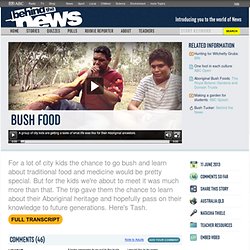
But for the kids we're about to meet it was much more than that. The trip gave them the chance to learn about their Aboriginal heritage and hopefully pass on their knowledge to future generations. Here's Tash. NATASHA THIELE, REPORTER: It's not every day you get the chance to experience how your grandparents lived. But these guys are about to do just that. ROD: The world's so modern today that you know the culture is starting to be forgotten you know, Aboriginal culture, the customs, even about the bush foods you know so it's every important you pass it on to your children.
Part of the experience is finding bush food. ROD: Get that nut up there. KID 1: It does taste like lime cordial, quite chewy. ROD: Mainstream people called them wild bananas, but we call them yulagi. KID 2: What do you think it tastes like? KID 3: Wild. ROD: Let me unhook him, there you go. Living Country (2005) clip 3 on ASO. Clip description A group of women sitting on the ground digging with digging sticks.
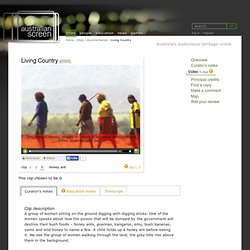
One of the women speaks about how the poison that will be dumped by the government will destroy their bush foods – honey ants, goannas, kangaroo, emu, bush bananas, yams and wild honey to name a few. A child holds up a honey ant before eating it. Narbalek (2001) clip 3 on ASO. Bushfood Bush Tucker Taste Australia. Top 10 Aboriginal bush medicines. THE CHINESE DRANK TEA from sweet wormwood leaves to cure chills and fevers, Egyptians used a herb from a plant called khella to help pass kidney stones, and all around the world, leeches were placed on sores to stop blood from clotting.

While these traditional methods of treatment are well known natural cures, Australian bush medicine, much like the bush itself is still very much a mystery. "A lot of information is lost," says Dr Evelin Tiralongo a pharmacist and expert in complementary medicine from Griffith University in Queensland. "[In Aboriginal culture], nothing is written down; instead, it's passed on through singing and dancing ceremonies, which are becoming increasingly rare. " According to Evelin most Aboriginal medical treatments were derived from food. Medicine. Aboriginal Art and Patterning - Art for Kids! Aboriginal Art Online - Contemporary Art and Traditional Symbols. Traditional symbols are an essential part of much contemporary Aboriginal art. Our online galleries offer a wide range of art works using traditional and contemporary imagery and symbols. Aboriginal peoples have long artistic traditions within which they use conventional designs and symbols.
These designs when applied to any surface, whether on the body of a person taking part in a ceremony or on a shield, have the power to transform the object to one with religious significance and power.